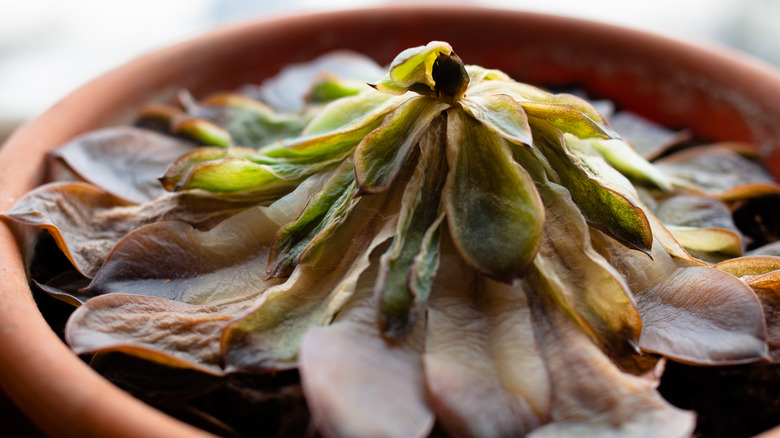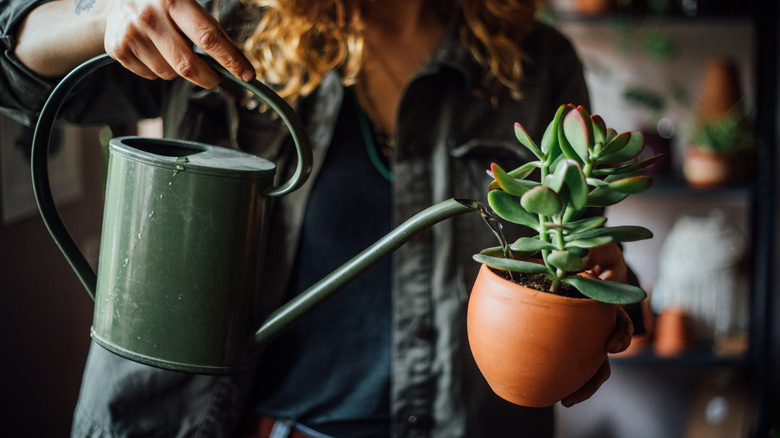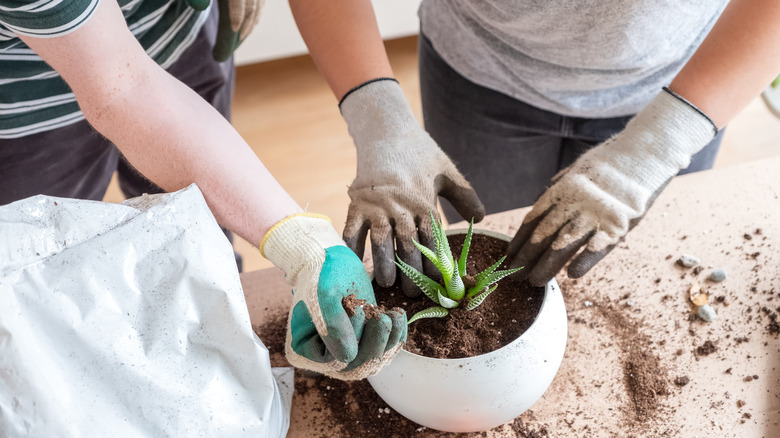Here's Why Your Succulent Leaves Are Turning Yellow
Succulents have surged in popularity as houseplants due to their fun and eclectic appearances and low maintenance. Their unique shapes and vibrant colors are Instagrammable and excellent at adding a pop of color or pizzazz to your decor aesthetic; however, despite their resilience, succulents are prone to watering issues that can result in yellowing leaves.
This plant has evolved to survive in arid conditions by storing water in its thick leaves and stems. This water storage adaptation enables it to withstand droughts, making it seemingly easy to care for. Yet, when exposed to overwatering, its water-storing capacity can lead to root rot, a condition where roots drown due to excess moisture. As a consequence, leaves turn yellow and become limp as the plant struggles to process excess water.
To maintain the health of succulents, it's important to observe a watering routine that allows the soil to dry out completely between watering sessions. Using well-draining soil and pots with proper drainage holes also aids in preventing waterlogged conditions. By understanding and addressing these watering intricacies, succulent enthusiasts can ensure their beloved plants retain their beauty and thrive in indoor environments.
How to identify watering issues for succulents
Yellowing leaves on your succulents are a clear sign of watering issues. On one hand, overwatering in succulents can manifest through distinct leaf changes. One clear sign is the yellowing of leaves, often accompanied by a mushy or translucent texture. The leaves might appear swollen and feel waterlogged or squishy to the touch. Another indicator is the development of black or dark brown spots on the leaves, signaling the onset of rot due to excessive moisture. The plant's growth might slow down, and it could start losing lower leaves as it reallocates resources to survive the excess water stress. Over time, the plant's overall health will likely decline, leading to a weakening appearance and a potential increase in pest susceptibility.
Conversely, underwatering is marked by different leaf responses. When a succulent lacks adequate water, its leaves might become wrinkled, thin, or shriveled. In extreme cases, they could appear slightly translucent and brittle. Yellowing leaves can also be a sign of underwatering, but in this scenario, the yellowing tends to start from the tips of the leaves and gradually moves inward. The plant might prioritize preserving its water by closing its stomata — tiny openings on the leaves — to reduce water loss, resulting in a closed or tight appearance. Growth may stall or become stunted, and the overall plant might seem smaller than usual.
How to overcome watering issues for succulents
To accurately gauge the water needs of succulents, it's essential to closely observe their leaves and adapt watering practices accordingly. If a succulent has been overwatered, you'll need to take swift action to save your plant. Remove it from its damp soil and inspect the roots for signs of rot, which appear brown and mushy. Trim away any affected roots using clean, sterilized scissors or pruning shears. Allow the plant to dry out by placing it in a well-ventilated area for a few days. Ensure the pot has proper drainage, and repot the succulent in fresh, well-draining soil. Adjust your watering routine to let the soil dry out completely before watering again. Moisture meters are great tools to accurately gauge soil moisture levels and help to avoid overwatering in the future.
When resurrecting an underwatered succulent, begin by gently watering the plant, ensuring the water reaches the root zone. Gradually increase the watering frequency, allowing the soil to be thoroughly moistened but not soggy. Consider placing the pot in a larger container with a layer of pebbles and water to boost humidity around the plant. Mist the leaves occasionally to prevent excessive water loss and encourage growth. If the plant's leaves are severely shriveled, you can carefully trim off the most damaged parts, but avoid removing too much at once to prevent shock. With consistent care and proper hydration, the succulent should gradually recover and display healthier growth patterns.


